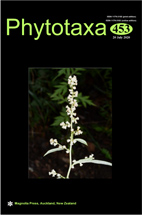Abstract
Micropsalliota embraces approximately 70 species which are mainly distributed in tropical and subtropical areas. In this study, two new species named Micropsalliota albella and M. purpureobrunneola are introduced from northern Thailand. Phylogenetic analyses based on ITS and LSU data shows their placement in Micropsalliota in two distinct lineages. Micropsalliota albella is characterized by the white, tiny basidiomes and utriform cheilocystidia. Micropsalliota purpureobrunneola is characterized by the pileus finely covered with purple to brownish-purple scales, oblong basidiospores and narrowly clavate cheilocystidia. Descriptions, colour photographs and illustrations of both new species are presented.
References
Edgar, R.C. (2004) MUSCLE: multiple sequence alignment with high accuracy and high throughput. Nucleic Acids Research 32: 1792–1797.
<a href="https://doi.org/10.1093/nar/gkh340">https://doi.org/10.1093/nar/gkh340</a>
Guzmaìn-Daìvalos, L. (1992) First record of the genus Micropsalliota (Basidiomycotina, Agaricaceae) in Mexico. Mycotaxon 43: 199–205.
Guzmaìn-Daìvalos, L. & Heinemann, P. (1994) Micropsalliota subalpina nov. sp. (Agaricaceae) from Mexico. Bulletin du Jardin Botanique National de Belgique 63: 195–199.
Hall, T. (2007) BioEdit v7. Ibis Biosciences, Carlsbad. [http://www.mbio.ncsu.edu/BioEdit/BioEdit.html]
Heinemann, P. (1956) Champignons reìcolteìs au Congo Belge par Madame M. Goossens-Fontana. II. Agaricus Fries s.s. Bulletin du Jardin botanique de l’état, Bruxelles 26: 1–127.
Heinemann, P. (1976) The genus Micropsalliota. Kew Bulletin 31: 581–583.
Heinemann, P. (1980) Les genres Agaricus et Micropsalliota en Malaisie et en Indoneìsie. Bull Jard Bot Natl Belg 50: 3–68.
Heinemann, P. (1983) Cleì de determination de Micropsalliota (Agaricaceae) et description de deux espeÌces nouvelles. Bulletin du Jardin Botanique National de Belgique 53: 85–95.
Heinemann, P. (1989) Le genre Micropsalliota en Ameìrique tropicale et subtropicale. Bulletin du Jardin Botanique National de Belgique 59: 459–466.
Heinemann, P. & Little Flower, S. (1983) Micropsalliota de Kerala (Inde). Bulletin du Jardin Botanique National de Belgique 53: 75–84.
Largent, D. (1986) How to identify mushrooms to genus I: macroscopic features. Mad River, Eureka.
Moncalvo, J.-M., Lutzoni, F.M., Rehner, S.A., Johnson, J. & Vilgalys, R. (2000) Phylogenetic relationships of agaric fungi based on nuclear large subunit ribosomal DNA sequences. Systematic Biology 49: 278–305.
<a href="https://doi.org/10.1093/sysbio/49.2.278">https://doi.org/10.1093/sysbio/49.2.278</a>
Nylander, J. (2004) MrModeltest v2. Program distributed by the author. Evolutionary Biology Centre, Uppsala University
Parra, L.A., Tan, Y., Xu, M.-L., Zhou, J.-L., Wang, B. & Zhao, R.-L. (2016) A reexamination of Allopsalliota indicates synonymy with Micropsalliota (Agariceae, Agaricaceae, Agaricales, basidiomycota). Mycoscience 57: 303–310.
<a href="https://doi.org/10.1016/j.myc.2016.02.005">https://doi.org/10.1016/j.myc.2016.02.005</a>
Pegler, D. & Rayner, R. (1969) A contribution to the Agaric flora of Kenya. Kew Bulletin 23: 347–412.
Silvestro, D. & Michalak, I. (2012) raxmlGUI: a graphical front-end for RAxML. Organisms Diversity & Evolution 12: 335–337
<a href="https://doi.org/10.1007/s13127-011-0056-0">https://doi.org/10.1007/s13127-011-0056-0</a>
Wei, L., Li, Y.-H., Hyde, K.D. & Zhao, R.-L. (2015) Micropsalliota pseudoglobocystis, a new species from China. Mycotaxon 130: 555–561.
<a href="http://dx.doi.org/10.5248/130.555">http://dx.doi.org/10.5248/130.555</a>
Zhao, R.-L., Desjardin, D.E., Soytong, K., Perry, B.A. & Hyde, K.D. (2010) A monograph of Micropsalliota in northern Thailand based on morphological and molecular data. Fungal Diversity 45: 33–79.
<a href="https://doi.org/10.1007/s13225-010-0050-4">https://doi.org/10.1007/s13225-010-0050-4</a>

